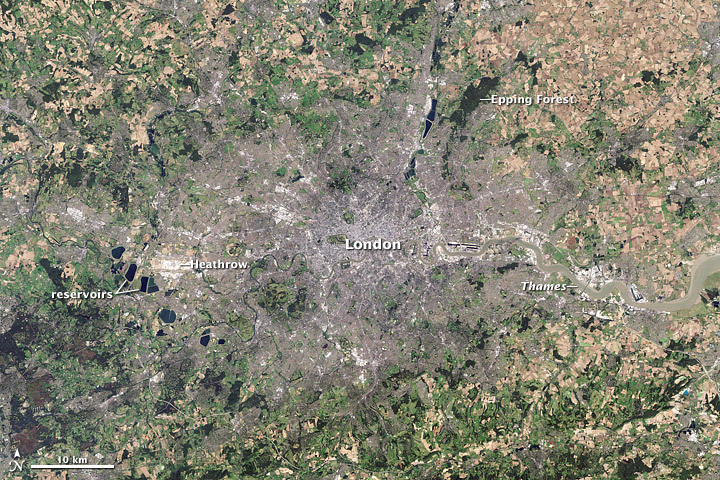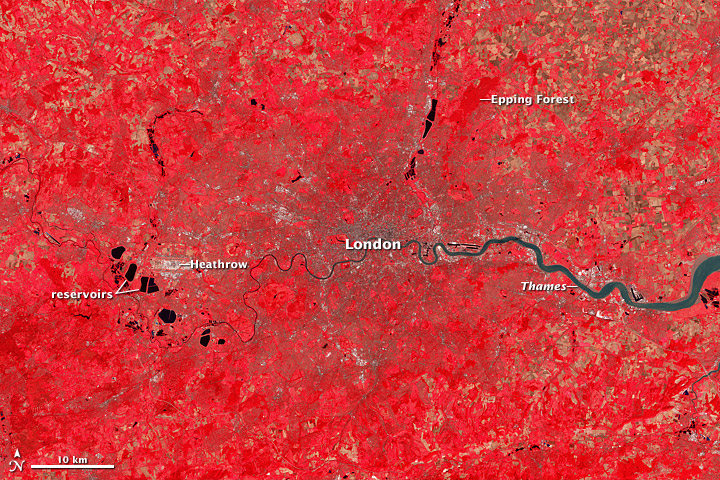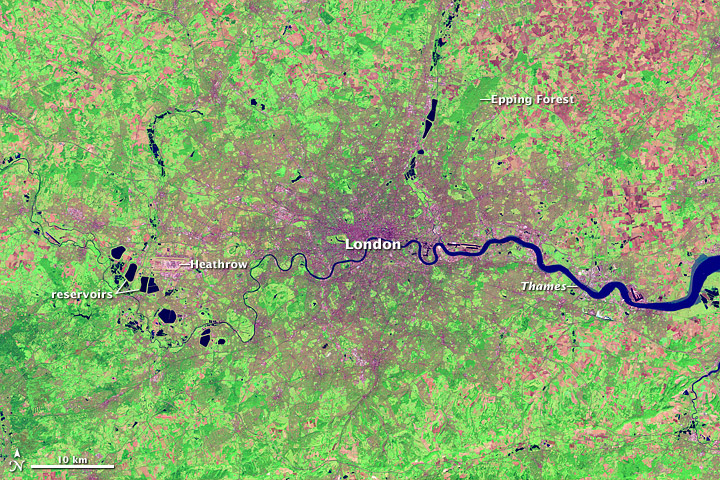NASA: United Kingdom - England - The Many Hues of London - August 2012
Posted by Ricardo Marcenaro | Posted in NASA: United Kingdom - England - The Many Hues of London - August 2012 | Posted on 12:15

Band Combination: 3, 2, 1.
acquired September 13, 2002
download large Band Combination: 3, 2, 1. image (7 MB, JPEG, 5011x3341)

Band Combination: 4, 3, 2.
acquired September 13, 2002
download large Band Combination: 4, 3, 2. image (6 MB, JPEG, 5011x3341)

Band Combination: 7, 4, 2.
acquired September 13, 2002
download large Band Combination: 7, 4, 2. image (7 MB, JPEG, 5011x3341)
acquired September 13, 2002
download Google Earth file (KML)
The Enhanced Thematic Mapper Plus (ETM+), the sole instrument on the Landsat 7
satellite, is far more than a camera. While a typical point-and-shoot
digital camera takes one picture of a scene based on information from
the visible portion of the electromagnetic spectrum, the ETM+ generates eight separate views of everything it images.
The ETM+ senses electromagnetic radiation in seven different bands,
plus an additional panchromatic band that combines a broad range of
wavelengths to create a high-resolution image. Three of them (bands 1,
2, 3) are in the visible portion of the spectrum and correspond to blue,
green, and red light. The other four bands (4, 5, 6, 7) fall in the
infrared portion. Band 4 is near infrared, with a slightly longer
wavelength than visible light. Bands 5 and 7 are longer still, in the
shortwave infrared portion of the spectrum. Band 6 detects thermal
infrared radiation, or radiant heat. Band 8 is the broad panchromatic
band that incorporates visible and infrared light. Researchers can
combine three of the six visible, near infrared, and shortwave infrared
bands to generate different types of natural-color and false-color images.
Combining the three visible bands produces a natural-color view, such
as the top image of London. Natural-color images look familiar to human
eyes: the canopy of Epping Forest is green; the reservoirs near
Heathrow Airport are dark blue; and the city itself is gray.
Natural-color images offer the best view of city infrastructure,
sediment, and bathymetry. However, it can be difficult to distinguish between different types of vegetation and between clouds and snow.
In the middle image, data from one of the infrared bands (4) has been
combined with the green (3) and blue (2) bands to create a 4-3-2
false-color view of London. This is a widely-used combination that is
especially useful for studies of vegetation, as different types and
densities of plants reflect infrared light in different ways. Coniferous
forests, for example, appear darker red than hardwoods. Also, deep red
hues indicate dense vegetation, while lighter reds indicate grasslands
or sparsely vegetated areas.
The bottom image is another type of false-color image made from a
combination of bands 7, 4, and 2 (two infrared bands plus green). This
combination is especially useful for geological, agricultural, and
wetlands research because band 7 can help discriminate between various
rock and mineral types. Bright green spots indicate vegetation and the
waters appear dark blue or black. Urban areas appear as gray or pink,
while cleared fields appear tan or purple.
Further Reading
- NASA Landsat Education and Public Outreach Team (2006, June) How Landsat Images Are Made (pdf). Accessed July 26, 2012
- Geospatial Data Service Center (n.d.) Band Combinations. Accessed July 26, 2012
- Quinn, J. (2001) Landsat Band Combinations. Accessed July 26, 2012
- NASA Landsat Education and Public Outreach Team (n.d.) Landsat 7 Compositor (pdf) Accessed July 26, 2012
NASA Earth Observatory images by Robert Simmon, using Landsat data from the USGS Global Visualization Viewer. Caption by Adam Voiland.
- Instrument:
NASA: United Kingdom - England - The Many Hues of London - August 2012
Ricardo M Marcenaro - Facebook
Operative blogs of The Solitary Dog:
solitary dog sculptor:
http://byricardomarcenaro.blogspot.com
Solitary Dog Sculptor I:
http://byricardomarcenaroi.blogspot.com
Para:
comunicarse conmigo,
enviar materiales para publicar,
propuestas:
marcenaroescultor@gmail.com
For:
contact me,
submit materials for publication,
proposals:
marcenaroescultor@gmail.com
Diario La Nación
Argentina
Cuenta Comentarista en el Foro:
Capiscum
My blogs are an open house to all cultures, religions and countries. Be a follower if you like it, with this action you are building a new culture of tolerance, open mind and heart for peace, love and human respect.
Thanks :)


Comments (0)
Publicar un comentario